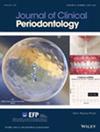牙周炎患者口腔-肠道生态失调和全身标志物的家族性模式
IF 6.8
1区 医学
Q1 DENTISTRY, ORAL SURGERY & MEDICINE
引用次数: 0
摘要
目的探讨父母的牙周炎是否与他们自己和孩子的粪便微生物群和系统标志物的差异有关。方法将80例患者分为4组(n = 20):患有牙周炎(PP)的父母;健康父母(PC);和他们各自的孩子(CP, CC)。记录临床牙周参数。通过16S rRNA测序分析唾液和粪便细菌DNA。测定唾液乳铁蛋白、粪便钙保护蛋白、龈沟液细胞因子(IFN‐γ、IL‐10、IL‐17、IL‐1β、IL‐4、TNF‐α)和尿肠通透性标志物(claudin‐2、‐3、‐4、haptoglobin)。结果患有牙周炎的父母表现出明显的粪便微生物群特征,这反映在他们的孩子身上,并且与对照组有显著差异。PP组和CP组的Claudin‐2水平均升高(p < 0.05),且与口腔生态失调指数和粪便厚壁菌门/拟杆菌门比值呈正相关。结论父母的牙周健康可能影响后代的粪便微生物群和系统标志物。这些发现强调了口腔肠道微生物传播的潜在途径及其与全身健康的相关性,值得进一步研究。本文章由计算机程序翻译,如有差异,请以英文原文为准。
Familial Patterns of Oral–Gut Dysbiosis and Systemic Markers in Periodontitis
AimTo investigate whether periodontitis in parents is associated with differences in the faecal microbiome and systemic markers in both themselves and their children.MethodsEighty participants were divided into four groups (n = 20): parents with periodontitis (PP); healthy parents (PC); and their respective children (CP, CC). Clinical periodontal parameters were recorded. Saliva and faecal bacterial DNA were analysed via 16S rRNA sequencing. Salivary lactoferrin, faecal calprotectin, gingival crevicular fluid cytokines (IFN‐γ, IL‐10, IL‐17, IL‐1β, IL‐4, TNF‐α) and urinary intestinal permeability markers (claudin‐2, ‐3, ‐4, haptoglobin) were quantified.ResultsParents with periodontitis showed distinct faecal microbiota profiles, which were mirrored in their children and significantly differed from controls. Claudin‐2 levels were elevated in both PP and CP groups (p < 0.05) and positively correlated with the oral dysbiosis index and the faecal Firmicutes/Bacteroidetes ratio.ConclusionsParental periodontal health appears to influence the faecal microbiome and systemic markers in the offspring. These findings highlight a potential pathway for oral–gut microbial transmission and its relevance to systemic health, warranting further investigation.
求助全文
通过发布文献求助,成功后即可免费获取论文全文。
去求助
来源期刊

Journal of Clinical Periodontology
医学-牙科与口腔外科
CiteScore
13.30
自引率
10.40%
发文量
175
审稿时长
3-8 weeks
期刊介绍:
Journal of Clinical Periodontology was founded by the British, Dutch, French, German, Scandinavian, and Swiss Societies of Periodontology.
The aim of the Journal of Clinical Periodontology is to provide the platform for exchange of scientific and clinical progress in the field of Periodontology and allied disciplines, and to do so at the highest possible level. The Journal also aims to facilitate the application of new scientific knowledge to the daily practice of the concerned disciplines and addresses both practicing clinicians and academics. The Journal is the official publication of the European Federation of Periodontology but wishes to retain its international scope.
The Journal publishes original contributions of high scientific merit in the fields of periodontology and implant dentistry. Its scope encompasses the physiology and pathology of the periodontium, the tissue integration of dental implants, the biology and the modulation of periodontal and alveolar bone healing and regeneration, diagnosis, epidemiology, prevention and therapy of periodontal disease, the clinical aspects of tooth replacement with dental implants, and the comprehensive rehabilitation of the periodontal patient. Review articles by experts on new developments in basic and applied periodontal science and associated dental disciplines, advances in periodontal or implant techniques and procedures, and case reports which illustrate important new information are also welcome.
 求助内容:
求助内容: 应助结果提醒方式:
应助结果提醒方式:


